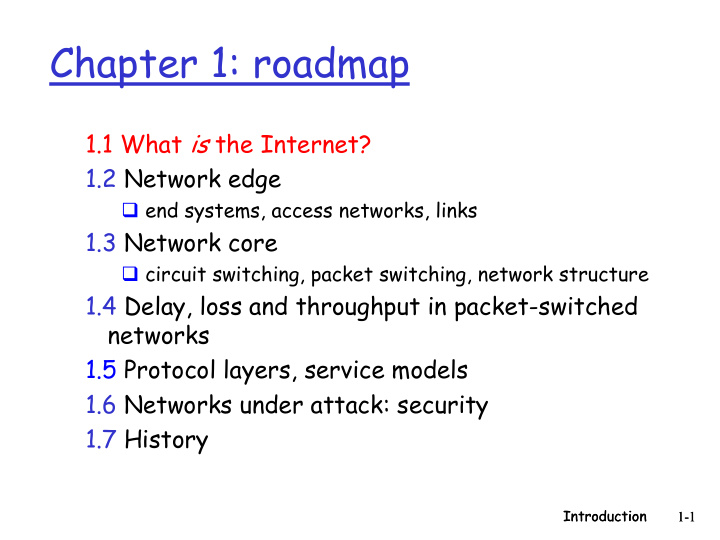



Chapter 1: roadmap 1.1 What is the Internet? 1.2 Network edge � end systems, access networks, links 1.3 Network core � circuit switching, packet switching, network structure 1.4 Delay, loss and throughput in packet-switched networks 1.5 Protocol layers, service models 1.6 Networks under attack: security 1.7 History Introduction Introduction 1-1 1-1
Kinds of networks � Local Area Network – LAN � Individual nodes know about each others' existence � Typically managed by a single administrative entity � Each node's configuration is known • Nodes often have a common, shared configuration – all MS -Windows, for example Introduction 1-2
Other networks � PSTN – Public S witched Telephone Network � Landlines, mobile/ cellphone networks � Usually interconnected � Owned/ operated by "telcos" � Cable TV networks � High capacity � Privately-owned infrastructure � Ham Radio � Informal, transient Introduction 1-3
Individual computer networks � ARPAnet � Csnet, BITnet, NS Fnet, Minitel � S pecific uses and members � Compuserve, AOL � Network services � Depended on PS TN landlines and modems for physical connections � These are Wide Area Networks - WAN s Introduction 1-4
1-5 Introduction BITnet, 1990
1-6 Introduction Fnet, 1991 NS
1-7 Introduction Compuserve, 1983
Connecting the networks - 1982 Introduction 1-8
Connecting the networks � ARPAnet, NS Fnet, BITnet all connected sites that maintained local area networks. � They evolved into the Internet . � Common set of rules for transmitting information packets between sites � Packet contents can be anything that both sender and recipient understand � The Internet is a "network of networks". � Edge networks that use Internet rules internally are known as "intranets" Introduction 1-9
What’s the Internet: “nuts and bolts” view � millions of connected Mobile network PC computing devices: server Global ISP hosts = end systems wireless laptop � running network cellular Home network apps handheld Regional ISP � communication links � fiber, copper, access points radio, satellite Institutional network wired � transmission links rate = bandwidth � routers: forward router packets (chunks of data) Introduction Introduction 1-10 1-10
What’s the Internet: a service view � communication infrastructure enables distributed applications: � Web, VoIP, email, games, e-commerce, file sharing � communication services provided to apps: � reliable data delivery from source to destination � “best effort” (unreliable) data delivery Introduction Introduction 1-11 1-11
What’s a protocol? human protocols: network protocols: � “what’s the time?” � machines rather than humans � “I have a question” � all communication � introductions activity in Internet governed by protocols … specific msgs sent … specific actions taken protocols define format, when msgs received, order of msgs sent and or other events received among network entities, and actions taken on msg transmission, receipt Introduction Introduction 1-12 1-12
What’s a protocol? a human protocol and a computer network protocol: Hi TCP connection request Hi TCP connection Got the response time? Get http://www.awl.com/kurose-ross 2:00 <file> time Q: Other human protocols? Introduction Introduction 1-13 1-13
Recommend
More recommend